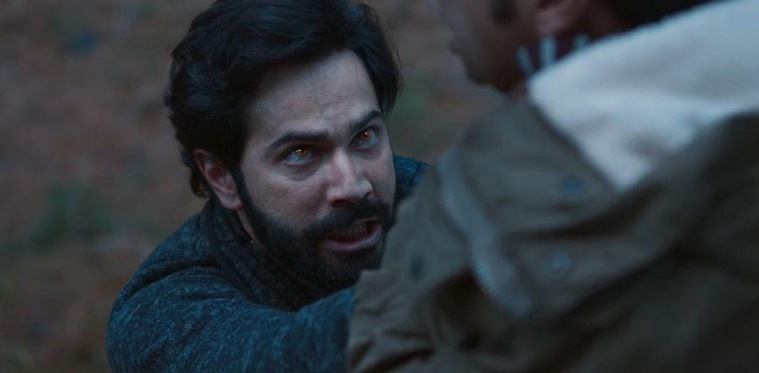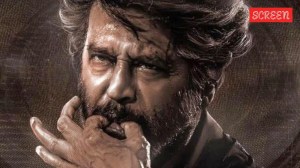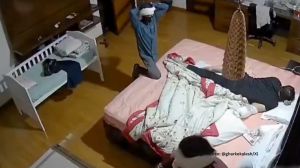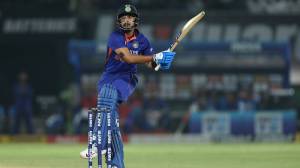Click here to follow Screen Digital on YouTube and stay updated with the latest from the world of cinema.
Bhediya director Amar Kaushik breaks down Varun Dhawan’s werewolf transformation, Om Raut’s explanation of Adipurush’s questionable VFX
In today's installment of Scene Stealer, we break down the horrific but hilarious transformation of Bhediya star Varun Dhawan into a werewolf, with filmmaker Amar Kaushik.
 Varun Dhawan played the lead role in Bhediya.
Varun Dhawan played the lead role in Bhediya. Varun Dhawan and Kriti Sanon’s horror-comedy Bhediya might not have had much luck at the box office, but it sure managed to entertain nearly everyone who saw it in theatres. The film was not without its flaws, but there were many things to be admired about it, including the acting, directing, visual effects, horror and the neat blend of comedy and its darker counterparts, which filmmaker Amar Kaushik has now become something of an expert in, thanks to the success of his previous films Bala and (more prominently), Stree.
One of the most entertaining sequences of Bhediya is actually its very first transformation featuring Dhawan, who, much to his horror, contorts himself to become a wild beast, The Bhediya. We see the actor’s bones breaking and hear its loud crack as he painfully moves about to develop into something more sinister-looking. There is little VFX used here, according to director Amar Kaushik, who said he wanted to keep things on the natural side for the first conversion.
Speaking to indianexpress.com, the filmmaker shared that before they had begun filming for Bhediya, Varun Dhawan had a more buff physique: “So when we began, Varun had a very muscular, buff body, but because he is said to transform into a werewolf so many times in the movie, I wanted the protagonist to be more loose and flexible, more in tandem with a normal, regular guy; on the leaner side. So I asked him to lose weight accordingly.”
The around two-three minute sequence is one-take with no cuts in between. The camera moved in from outside the window into the house and then focused on the space where Dhawan’s metamorphosis was taking place.
“I wanted that sequence to be a one-take thing, because usually when you see such segments, you first see the person’s legs and then arms and torso etcetera getting morphed into this beast-like creature, but I wanted everything to be a one-shot scene so that even the international audience would be left surprised upon seeing it. There was no cut in between. I had said that at first there will be no VFX because I wanted the whole thing to come off so naturally, that even without CG, you should be able to make out that the bones of this person are being twisted and broken in ten different ways at once,” Amar Kaushik told us.
Varun Dhawan ended up doing the same bone-breaking routine at least 20 more times, but ultimately the filmmaker chose to go with the first take, much like he had done during Bala‘s climax with Yami Gautam and Ayushmann Khurrana.
“We took almost 20 takes of that, but I used the first take again, like I did during Bala’s climax. So Varun got the bruises and scratches from doing that scene again and again, but when he asked me which take did I use and I told him the very first, he was like ‘What?'” the Bhediya director laughed aloud upon recalling his lead star’s reaction.
 Varun Dhawan in a still from Bhediya.
Varun Dhawan in a still from Bhediya.
As mentioned previously, Bhediya has made excellent use of CG, which maybe some of our desi films can learn from (cough Adipurush). The Om Raut directorial, which is mounted on a massive scale, had released its teaser a while ago that was unanimously panned by everyone on the internet. Raut’s explanation for bad effects were perhaps even more incredulous than the visuals he had displayed in that first look — ‘Adipurush is meant to be consumed on celluloid, and not on YouTube.’ So the blame was deflected towards the medium. However, Raut has promised that no one will have complains when the film eventually sees the light of day. But what does someone like Amar Kaushik, who used CG a fair amount in his latest venture, has to say about Raut’s explanation; is it a valid one at all?
Speaking about his own movie and his process of going about things, Kaushik said, “We should give more time to the VFX company, and it is also about the planning — how well have you planned things ahead? We were very clear that we would be using CG in these 13-14 bits. So this prep happens completely separately. You can improvise with other departments of filmmaking, but once the model of VFX is set, there is not much you can do about it. And during lockdown, I even did a course on the basic concepts of VFX, so that when we sit down to discuss, I could understand and contribute too. After all, it is the director’s vision that is coming to life.”
As far as Om Raut’s response of getting a better experience on big screen is concerned, the Stree director stated, “So I think Avatar or films like that, we also see them on our phones and TV, right? Waha pe toh thik dikhte hi hai na wohi bhi (Those appear just fine on our screens, despite their heavy visuals effects). So I don’t know why he (Om Raut) said that, kuch soch ke hi bola hoga (he must have thought this through), but I feel that your films should work on every screen, whether it be a mobile, TV or theatre.”
Ask him about the plans of intermingling the worlds of Stree and Bhediya, and bringing in Ayushmann Khurrana along for the ride, Amar Kaushik left things open-ended, much like his films, as he said with a hint of a smile “Kuch na kuch to hoga hi” (Something will happen on that front, definitely). Well, we will wait.


Photos



- 01
- 02
- 03
- 04
- 05




























